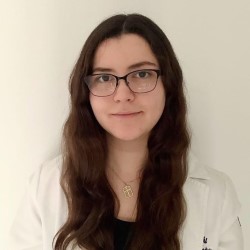by Lourdes Gil-Flores
Patients rely on their caregivers to heal them, solve any health issues they may have, and assist them in improving their quality of life. The health care profession is entrusted with a great deal of responsibility. Providing excellent patient care is rooted in humanism. Besides mastering clinical sciences, the practice of medicine also requires humanism (1). Focusing on the patient as a whole reminds us that medicine encompasses more than the diagnosis and treatment of physical conditions. Self-awareness is a core element of humanism, where health care providers recognize the impact of their interactions with patients (2).
Empathy for the patient is one of the goals of medical education. Facing pain and suffering becomes a need to treat others with kindness and provide understanding. Activities such as being admitted to the hospital and accompanying patients on medical visits are ways to gain empathy for the experiences of patients with illness (3).
When I started medical school, I always wondered how my first clinical experiences would be. I couldn't wait to start my intern years. I used to picture myself in the hospital caring for patients, suturing wounds, being in the polytrauma section, and feeling the rush of an emergency. The moment finally came during my fifth year as a medical student.
I was in my internal medicine rotation, usually an easeful one, monitoring patients, taking them to imaging or lab studies, or watching procedures. It was 6 p.m. when I arrived for my shift, and the residents in charge of me were not where they usually were. I assumed there would be nothing to do, but—not a minute later—another student asked me if I was on call. When I said yes, she said, “Come; a patient is crashing!” A ton of thoughts ran through my head—”I haven't seen this before. I have only given CPR in simulated practices; do I still remember how to do it? How similar is it to a real patient? And if I do it wrong?”
At the time I entered the room, a multidisciplinary team was already in place. Seven students were taking turns giving CPR, a resident with a defibrillator was in position, and nurses were administering adenosine. “I found a pulse!” I heard, and I felt relief. Throughout my medical preparation, I had been waiting for a moment like this, where I could intervene during a critical situation. As I was bagging the patient, I saw her eyes. When I became aware of the situation, I began to analyze it. There were 15 people trying to save her life in a room shared with five other patients. She is breathing because someone is manually doing it for her; she will be in pain when she recovers consciousness. Her family probably does not yet know what's going on, and she is in a very vulnerable position: this is not a disease, this is a person. I felt the human side of medicine.
The need for a multidisciplinary team in which everyone is equally important became clear to me during the intervention. I learned to remain calm and cold-hearted, and witnessed the delicate balance between life and death very closely.
My experience taught me something that books could never teach. In class, we are encouraged to care for our patients and we are taught the importance of dealing with human lives. But it is only when you are there that you really understand compassion and empathy for the patient. Through these approaches, we can develop a sense of humanity and recognize that empathy is a quality that every caregiver should have. Medical training is the best time to begin cultivating these attributes.
My first encounter with a critical patient left a hallmark. It established the kind of doctor I want to become: I want to be connected to the suffering other, to provide the best care possible, and to acknowledge life's fragility.
References
- Buck E, Holden M, Szauter K. A methodological review of the assessment of humanism in medical students. Acad Med. 2015;90:S14-S23. [PMID: 26505097] doi:10.1097/ACM.0000000000000910
- Lee Roze des Ordons A, de Groot JM, Rosenal T, et al. How clinicians integrate humanism in their clinical workplace-’Just trying to put myself in their human being shoes'. Perspect Med Educ. 2018;7:318-324. [PMID: 30298438] doi:10.1007/s40037-018-0455-4
- Shapiro J. Walking a mile in their patients' shoes: empathy and othering in medical students' education. Philos Ethics Humanit Med. 2008;3:10. [PMID: 18336719] doi:10.1186/1747-5341-3-10

Lourdes Gil-Flores
Universidad Autónoma de Nuevo León
Graduating Class of 2023
Back to the September 2023 issue of ACP IMpact

